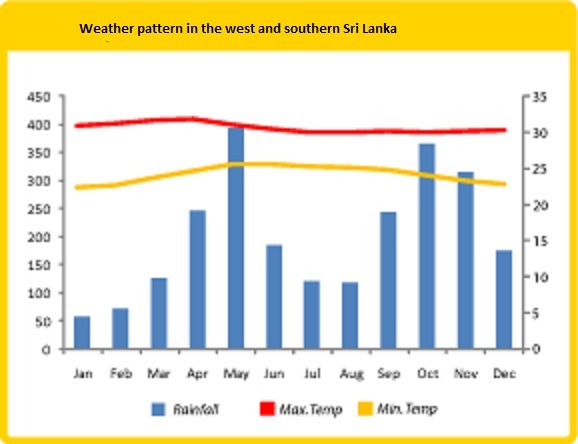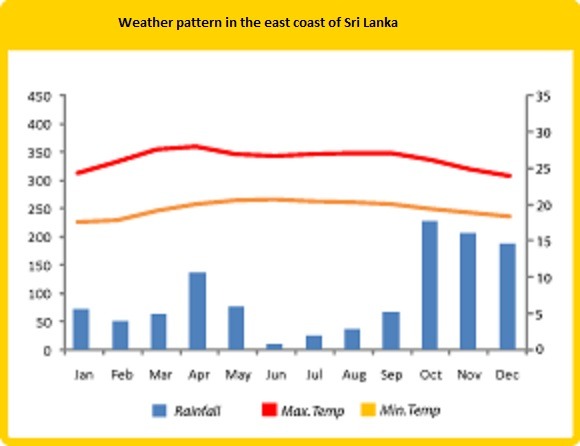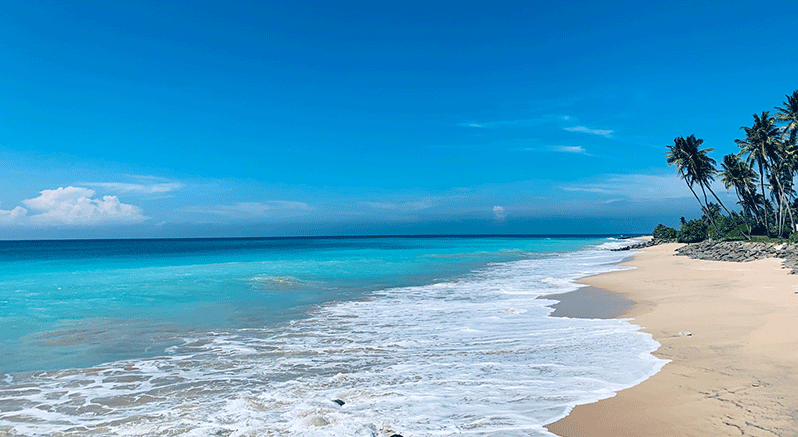Sri Lanka Weather Pattern And Holidays In Sri Lanka
Table of Contents
- Sri Lanka weather pattern And Sri Lanka rainy season
- A slight change in the weather pattern in 2020
- Bad weather in the month of October
- Affordable Sri Lanka beach holiday
- Adventure tour package
- Sri Lanka rainy season
- Monsoon decides the Sri Lanka rainy season
- Sri Lanka hill country weather and holiday
- Sri Lanka dry zone rainy period
- What is the best Best time to visit Sri Lanka
- Sri Lanka weather in November
- The yearly temperature of Sri Lanka
Sri Lanka weather pattern And Sri Lanka rainy season
According to the Sri Lanka weather pattern, dry weather settles over the most parts of Sri Lanka including west and south coast usually from November to April. The period from November to April considered being the best time of the year to travel to Sri Lanka, also called peak holiday season in Sri Lanka. The Sri Lanka rainy season of southern and western coast starts from May and ends in October.
Sri Lanka east coast, which is a bit less popular as a holiday destination, compared to the west coast, get the dry weather from May to October. However, which considered being the low season in Sri Lanka and the number of travellers during this period is considerably low.
The calm sea that resulted from the absence of monsoon from November to April has turned to placid water with enhanced visibility. Usually, the fair-weather condition in western and southern Sri Lanka usually remains until April every year.
A slight change in the weather pattern in 2020
There had been a notable change in the weather pattern in the first week of November, however, now it is turning to the usual weather conditions, making the south and western parts of Sri LankLanka,luding central mountain range suitable for outdoor activities. The rough sea that resulted due to the effect of monsoon has turned to placid water with enhanced visibility. The present fair weather condition in western and southern Sri Lanka expected to remain until April 2020.
As the weather turned to normal in the second week of November over the western and southern coast of Sri Lanka, it has become the best beach holiday destination in the island. In fact, From November to April is the best time of the year to explore the islands west and south due to the warm, sunny weather, enabling the travellers to engage in activities such as beach hopping, sunbathing, snorkelling, diving and many other saltwater activities.
Bad weather in the month of October
weather in the current month (October 2019) is unfavourable for holidays in Sri Lanka due to the heavy rain throughout the country. We have seen a shift in the weather pattern in October 2019. The weather in Sri Lanka in the month of October is usually wet.
However, towards the end of the month, the dry weather consolidates over most parts of the country, especially south-west Sri Lanka, in order to welcome the main tourist season. However, according to the met department, the showery conditions of Sri Lanka expected to remain until the first week of November.
Weather is perhaps the single most important factor when it comes to selecting a holiday destination. Therefore, I thought of making this note on Sri Lankan weather, to help our readers get more insight into Sri Lankan weather pattern and choose the best time to travel to Sri Lanka.
A large number of our readers ask questions like “When is the Sri Lanka rain season ?“, “When is the Sri Lanka dry season ?“, “What is the Sri Lanka weather in November ?” and “When is the best time to book Sri Lanka tours?” etc. So, I think this article going help most travellers who are curious about Sri Lankan weather pattern. If you need further information on this subject, please don’t hesitate to write to me.
Affordable Sri Lanka beach holiday
Studying the weather pattern of selected holiday destination is a fact of utmost importance. Bad weather can dampen your Sri Lanka trip. weather statistics of metrological departments of your holiday destination may give you a hint of the climate conditions for the next several weeks or months. But, sometimes you have to face the wrath of bad weather, despite the good weather conditions predicted by the meteorological department.
I think none of the holidaymakers love to stay in a hotel and only eat, drink and sleep. Everybody loves to go out, take sightseeing tours such as Sri Lanka 5 days trip, Sri Lanka nature tour and see the interesting places of the destination, meet people, and experience the life of people in a foreign country.
As you know the weather is unpredictable, there is no way of predicting the exact conditions for the future. According to the weather pattern, there are months, which suggest certain parts of Sri Lanka for holidays, either western or eastern corner. Sri Lanka is a tropical island and gets more rain than most countries in the world. Virtually there is no month without rain on the island and don’t be surprised to see a casual rain even during the driest period of the year.
Adventure tour package
Following description give you some ideas about the usual weather pattern in the island; it can be applied to the west coast, the most popular beach holiday destination on the island, it also can be applied to the east coast. As you keep on reading you will come to know that Sri Lanka is a beach holiday destination for the whole year.
Sri Lanka rainy season
When is the Sri Lanka rainy season in the East coast? – The rain season in the east coast from December to March
When is the Sri Lanka rainy season in the West coast? – The rain season on the west coast from May to October
I have highlighted the usual Sri Lanka rain season for the east coast and west coast. There is a slight change of this rain pattern every year but basically, the rainfall in the island resulted in 2 phases and different parts of the island coming under the heavy rain on each occasion. I have highlighted the rain season on the east and west coast. So, when you travel to the island next time, you can find the places where you can stay dry.

Monsoon decides the Sri Lanka rainy season
Sri Lanka weather can be categorized as warm tropical, which is under the influence of the Monsoon. Seasonal monsoon wind is the main contributor to the island’s rainfall that has six months changing the pattern, Summer monsoon (from April to November) and winter monsoon (November to April).
Sri Lanka hill country weather and holiday
The central hill country of Sri Lanka, which is mainly comprised of mountains, shows a totally different climate than the rest of the country. According to the Sri Lanka weather pattern, summer monsoon or North-East monsoon brings the rain from April to November and soaks the North, East, Southern and some parts of the Island’s central region.
More than half of the island’s land area is covered by the North-East monsoon and the area is categorized under the dry zone. Estimated yearly rainfall in the dry zone areas of the island including Jaffna peninsula is 1500 to 2500 mm.
Sri Lanka dry zone rainy period
The months of November, December and January considered being the main rainy period of the year for the dry zone. Yala national park and the surrounding of Kataragama are categorized under the arid zone with the minimum yearly rainfall in the island.
As the name suggests the area is dry for most of the year and the yearly rainfall estimated to be less than 1500 mm. The temperature of the dry zone is very high compared to the rest of the island and unlike other climate zones, most of the green cover is comprised of throne bushes.

West, South and South-West parts of the island are recording the highest rainfall in the island, which is between 2500 to 5000 mm. Wet zone of the island mainly comprised of low land of western Sri Lanka and the western side of the central mountain range.
Winter monsoon is the main contributor of yearly rainfall of wet zone. The monsoon wind enters the island from South-West part of the island and soaks the Western parts of the central mountains; the leeward side of the mountain range remains dry owing to the dry wind that resulted from the rain in the western part of the mountain range.
The wind which passes in the direction of the Eastern slope of the mountain range is called “Kachchan wind”, which is very dry as it dropped all of its water on the western slope of the mountain, and that increases the oppressive heat of the North and Eastern parts of Sri Lanka.
What is the best Best time to visit Sri Lanka
The unique pattern of the monsoon wind which changes in every six months makes Sri Lanka an ideal holiday destination at any time of the year in the region. Some parts of the island stay dry and show the best climate for holiday at any given time of the year.
When the North-East monsoon soaks the North and Eastern Sri Lanka west coast experience the dry weather while the South and Western Sri Lanka experience the rainy season from April to November, North and Eastern parts of the island experience the dry climate.
Sri Lanka weather in November
Generally, Sri Lanka weather in November is dry and humid. This is the month, in which monsoon migrate from west coast of Sri Lanka to the east coast. As it moves to the east coast from the west so is the rain, usually, the monsoon wind accompanies the heavy rain, gusty wind and lightning. During this transition, Sri Lanka weather in November is relatively dry throughout the island.
When the monsoon settled over the eastern part of the country over the next few weeks the entire east coast experience the heavy rain. But the dry weather settles over the west and southern part of the island and remains dry until the next change of monsoon wind in the month of May.
The yearly temperature of Sri Lanka
Being an island close to the equator, the temperature of Sri Lanka measured to be between 29 to 35 ˚C in the lower elevations (coastal areas), however, the temperature in the dry zone of Sri Lanka can o up to around 40 ˚C in the draught season.
The humidity of the lower elevation measured to be around 85% making it adding some discomfort for the existing high temperature. Constant wind of the beaches makes it more comfortable to live in the coastal belt than the cities that are away from the coast.
At the higher elevations of the island, is the more comfortable climate with low temperatures around 25˚C. Nuwara Eliya lies 2000 meters above sea level and records the lowest temperature in the island.
The temperature of Nuwara Eliya can fall up to -2 ˚C after the sunset in the months of November and December. The highest temperature of the island recorded in the North and Eastern parts of the island between 35 to 37 ˚C average temperatures.






